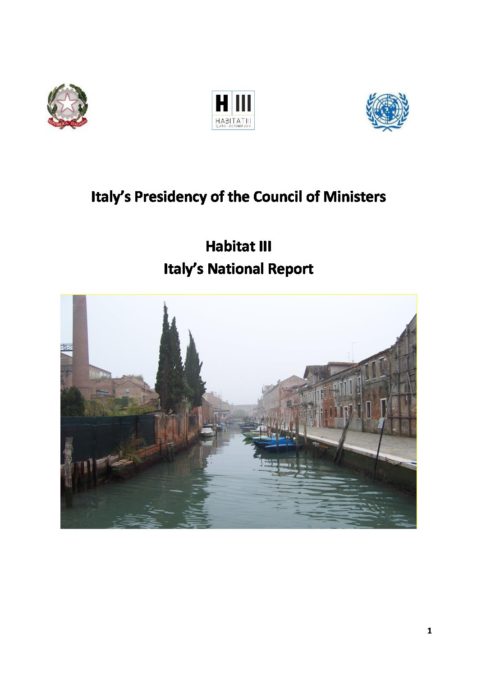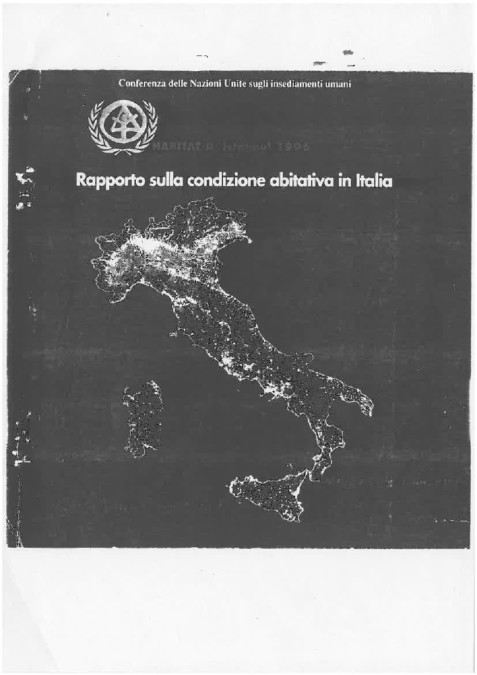

Italy
Urban indicators:
| Value | Year | ||
| Surface area (sq km) | 302073 | 2014 | |
| Population (proj., 000) | 59801 | 2016 | |
| Pop. density (per sq km) | 203.3 | 2016 | |
| Capital city | Rome | 2015 | |
| Capital city pop. (000) | 3718 | 2015 | |
| Population growth rate (average annual %) | 0.1 | 2010-2015 | |
| Urban population growth rate (average annual %) | 0.4 | 2010-2015 | |
| CO2 emission estimates (000 tons/tons per capita) | 344768/5.8 | 2013 | Including San Marino. |
| Population using improved drinking water sources (urban/rural, %) | 100.0/100.0 | 2015 | |
| Population using improved sanitation facilities (urban/rural, %) | 99.5/99.7 | 2015 |
| 1995 | 2005 | 2014/2015 | |
| Urban population ('000) | 38,124 | 39,743 | 42,166 |
| Level of urbanization (%) | 66.9 | 67.7 | 69.0 |
National Report:
National Report Executive Summary:
The Report describes the peculiarities of Italy’s situation and dimensions, characterised by a polycentric structure based both on large conurbations (metropolitan cities) and specifically vibrant medium-sized cities endowed with remarkable services supply systems, and on the presence of a high number of smaller realities. The Report aims to contribute knowledge, experiences and proposals which, although partial, will be a support to the strategic choices that may be undertaken subsequently.
Compared to the Habitat II Conference held back in 1996, Italy’s institutional and territorial organisation has strongly changed. We are witnessing an increasingly strong role played by urban institutions, on the one hand with the establishment of metropolitan cities and, on the other, with small administrative contexts strongly encouraged to merge. The successful conclusion of this process will be an important tool to set up better performing local investment strategies in order to improve inter-institutional dialogue for management of public municipal services, with the aim of implementing an efficient and effective synthesis of additional investments and ordinary policies.
Focus on cities has indeed grown, finding motivation and support within EU and national policies, through the 2014-2020 programming period of EU Structural Funds and use of national ordinary and cohesion resources. This Report may provide an opportunity to reflect on the economic and social process taking place within our cities, for promotion of management policies and reuse of building stock in order to feed the debate on the challenges related to planning and management of urban spaces, and acknowledging cities’ strategic role as development drivers.
Statistics:
Urban housing indicators
Urban population with access to adequate housing (%)
Basic services and infrastructure
Urban population with access to safe drinking water (%)
Urban population with access to adequate sanitation (%)
Urban population with access to regular waste collection (%)
Urban population with access to clean domestic energy (%)
Urban population with access to public transport (%)
Level of effective decentralization
Share of both income and expenditure allocated to local governments from the national budget (%)
Share of local authorities’ expenditure financed from local revenue (%)
Statements by Italy:
-
Habitat III Plenaries
Events:
- Regional and High Level Process:

- More events:

The Implementation Of The New Urban Agenda In Italy

Sustainable Food Systems in the New Urban Agenda

1st Expert Group Meeting for the preparation of the Regional Report for Europe

The news we need for the city


